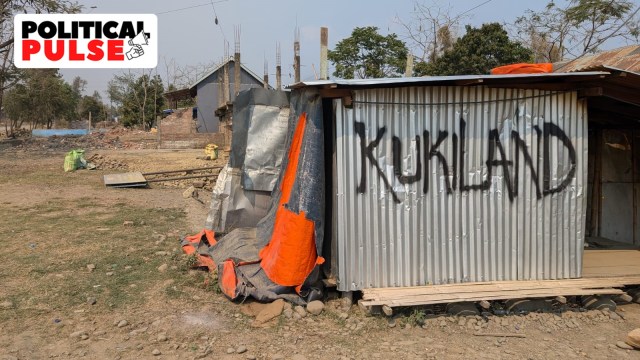Divide within a divide, latest Manipur violence exposes yet another ethnic faultline
Last week, a drunken brawl in Churachandpur escalated to violent clashes between Zomis on one side and Hmars and Kukis on the other, leaving one dead. Why were these groups fighting when all of them are categorised as Zo?
 A graffiti in Kangpokpi. (Express Photo: Sukrita Baruah)
A graffiti in Kangpokpi. (Express Photo: Sukrita Baruah)The stretch between the hill district of Churachandpur and Bishnupur district has been one of the most volatile areas of Manipur during the ongoing ethnic conflict, the site of heated exchanges of fire in which many lives have been lost. While this area has been quiet for several months — “volunteer checkposts” and bunkers where civilians, both armed and unarmed, monitored entry into Churachandpur are now gone — the attention of law enforcement, for now, has shifted to tensions in the district headquarters itself.
Last week, these tensions spilled over when violent clashes, leading to one death, broke out on the streets in the district after what, by all accounts, began as a drunken brawl in which an office-bearer of the Hmar community’s apex body Hmar Inpui was seriously injured. The violence then spiralled into clashes between members of the Zomi community on one side and Hmars and Kukis on the other side. After this, organizations representing these three groups — all of them come under the Zo umbrella — and Church leaders signed a joint agreement pledging “collective commitment to restoring peace, healing wounds, and building a future where all communities of Churachandpur can coexist with dignity and mutual respect”.
At the heart of the violence is a long struggle for power over Churachandpur and representation of the multiple small tribes that are clubbed together variously as Zo, Kuki-Zomi, Kuki-Zo, Kuki-Zo-Hmar, and so on. The tribes that identify as Zomi reject the term Kuki, pointing to its colonial origin, and opposition to “assimilation” by that hegemonic identity.
On Sunday, there was a meeting between Thanglianpau Guite and P S Haokip, the chiefs of influential insurgent organisations Zomi Reunification Organisation and Kuki National Organisation. Following their discussions, the two also issued a similar joint appeal. “This was a landmark meeting bringing them both together after a long time and was orchestrated with efforts from the police, security forces, and district administration to ensure peace,” said a security official.
 A truck damaged after the armed militants set it on fire in Jiribam district in Manipur, in November 2024. (PTI Photo)
A truck damaged after the armed militants set it on fire in Jiribam district in Manipur, in November 2024. (PTI Photo)
“The last major cycle of violence at the inter-district border was in August, September last year. Now all the ‘checkpoints’ have been removed and all the bunkers in the frontlines have either been removed or taken over by security forces. Now we are trying to maintain calm in the town, where it got very violent last week. For one, we have brought Church leaders together who are holding prayers for the unity of the people,” said a senior police officer.
This divide has also extended to the representation of Zo interests to the Centre over the ongoing conflict with Meiteis. It came to the fore recently during a meeting held by the Union Ministry of Home Affairs, led by its North East Advisor A K Mishra, with the representatives of groups in Churachandpur. The meeting was attended by leaders of both the Kuki Zo Council (KZC) — a conglomerate of different tribal organisations formed in October last year with the stated aim of “serving as the highest decision-making body for the community” to advance “collective interests” — and the Zomi Council that opposes its claim of broader representation.
“In the meeting, I proposed that there should be an agreement for cessation of hostilities between both parties, initiated by the MHA, since there is still the possibility of firing restarting anytime. By this, I don’t mean a surrender or a peace pact, just that both groups should agree not to fire and the buffer zones should be maintained as a first step to start any kind of dialogue. But now there are accusations that I am trying to make peace with Meiteis and sell out our interests,” said KZC chairman Henlianthang Thanglet.
Zomi Council chairman Vumsuam Naulak said, “We said we are not ready for this, the traumatic memories are too fresh. Cessation of hostility is an elaborate term. The main question is, ‘Are you ready to talk to Meiteis?’”
Naulak pointed to Union Home Minister Amit Shah’s statement in the Rajya Sabha on March 21 that “dialogue between both communities has started”. “The Home Minister is saying that talks have started between Kuki-Zo groups and Meiteis for the restoration of normalcy, but we are not part of any such talks. So, if talks are happening and we have been excluded, we can’t agree with any such engagement that leaves us out,” he said.
As this struggle for representation plays out, both leaders are competing in their claims of support of tribal bodies of different constituent tribes under the respective umbrellas, including some overlap of the same tribes.
“Churachandpur is very fragile now. There was a possibility of meeting the MHA again in April after talking to all the constituent bodies, who will speak to the blocks under them about the proposal of some cessation of hostilities. But that has to be delayed because we first have to address these internal issues. These are complicating our movement,” said Thanglet.
- 01
- 02
- 03
- 04
- 05































